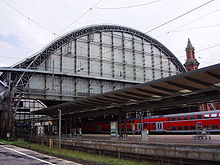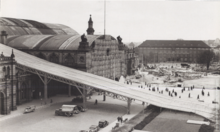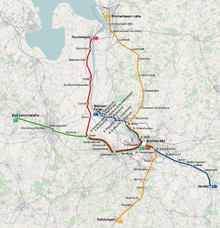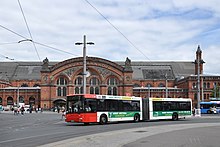Bremen Central Station
| Bremen Central Station | |
|---|---|
|
Bremen Central Station
|
|
| Data | |
| Operating point type | Through station |
| Location in the network | Junction station |
| Platform tracks | 9 |
| abbreviation | HB |
| IBNR | 8000050 |
| Price range | 2 |
| opening | 1847 (at different location) |
| Architectural data | |
| Architectural style | Neo-renaissance |
| architect | Hubert bull |
| location | |
| country | Bremen |
| Country | Germany |
| Coordinates | 53 ° 4 '59 " N , 8 ° 48' 49" E |
| Railway lines | |
|
|
| Railway stations in Bremen | |
Bremen Hauptbahnhof is the most important train station in the two-city state Free Hanseatic City of Bremen and is located northeast of the city center in the suburb of the station . It is the center for rail traffic in north-west Germany and, with around 140,000 passengers a day, is the 11th most frequented long-distance train station of Deutsche Bahn . Bremen's main train station is one of the 86 train stations (as of 2020) in price class 2 from DB Station & Service and was named Metropolitan Train Station of the Year by Allianz pro Schiene in August 2012 .
The building erected from 1885 to 1889 on Bremen's Bahnhofsplatz was designed by the architect Hubert Stier in the neo-renaissance style . Bremen Central Station is the hub for regional and local transport connections as well as long-distance transport . ICE -, Intercity and EuroCity - but also the regional S-Bahn stop here .
An average of 80 long-distance and 450 local trains run on nine tracks each day. In front of the station there are stops for city buses and trams from BSAG and other providers. Above the travel center near the main entrance there is a DB lounge on the first floor for frequent and 1st class travelers.
history
State train station / Hanover train station
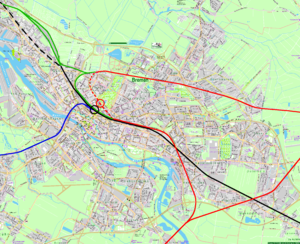
(entered in a current city map)
| black: | Royal Hanover State Railways |
| blue: | Oldenburg Railway |
| red: | Hamburg-Venloer Bahn |
| green: | New buildings from 1880 |
| dashed: | reduced |
| black ring: | State train station / main train station |
| red ring: | dismantled Hamburger Bahnhof |
Bremen's first train station was built as early as 1847 with the opening of the Wunstorf railway line by the Hannöversche Staatseisenbahn, directly west of today's main train station. The building with a classicist middle section and two side towers was based on plans by Alexander Schröder . By starting here have been in the years to Bremen-Bremerhaven railway , the railway Bremen-Oldenburg and Bremen State Railway to Uelzen (later " America Line ") opens. In 1885 the Hanover station was demolished.
Hamburger Bahnhof
When the Cologne-Mindener Eisenbahn-Gesellschaft (CME) reached Bremen in May 1873 during the construction of the Hamburg-Venloer Bahn , the old state train station was already well used and was only used temporarily. On August 16, 1873, the CME then opened its "Hamburger Bahnhof", also called "Venloer Bahnhof" or "Parkbahnhof", directly north of the site of today's town hall , as it bordered directly on the Bürgerpark .
At the time the Hamburg – Venloer Bahn was built, the Free Hanseatic City of Bremen (like Hamburg) was not yet a member of the German Customs Union , which it did not join until 1888. In order to be able to transport goods from the Rhenish-Westphalian industrial area to Harburg without leaving the German customs area , a line serving only goods traffic in accordance with the contract was led in a straight line east of Bremen, while west of the Hamburg train station the line in an arc of approximately 180 ° the Bürgerpark was built around, from where it still leads straight to Ottersberg .
Hauptbahnhof / Centralbahnhof
In the 1870s it was planned to build a central station as a wedge station in the area of today's street Am Barkhof , where the Hamburg – Venloer Bahn branched off from the Hanover state railway. However, due to the founders' crash in 1873, the implementation of these plans was delayed. After 1880, the decision was made to build the common main station just east of the previous Hanover station. During the construction work from 1885 to 1889, all rail traffic was handled by the Hamburger Bahnhof. At the same time, the bath opposite the train station in 1877 was given a ladies bath from 1887. A coin treasure was discovered that consisted of around 1300 coins from the 14th century.
With the new station, a new arch to the railway line to Hamburg was created. The new Bremen "Centralbahnhof" was opened on October 15, 1889. The Hamburger Bahnhof was then demolished, parts of the station area and the old route were used from 1900 to 1954 by the Bremen – Tarmstedt small railway .
In 1907 the track area of the main train station was expanded.
Tracks and station hall
Bremen Central Station is designed as a through station in a north-west-south-east direction and has nine platform tracks, seven of which are within the station hall. In addition, two through tracks for freight traffic run through the hall.
The hall roof was covered with glass until 1966 and supposedly was the only one of its kind in Germany to have survived the Second World War. Because of the soot and the risk of breakage, the skylight was replaced by wooden cladding with roofing felt.
A six-track railway body leaves the station in a south-easterly direction with the two lines to Osnabrück / Münster and Wunstorf / Hanover . About 3 km to the east, the route divides into Bremen-Hastedt , whereby the Osnabrück route initially runs north before it crosses the route to Wunstorf / Hanover in an arc to the south. Inside the arch is the so-called "Hastedter lens", an industrial area. The " Amerikalinie " in the direction of Berlin (via Uelzen , Stendal and Rathenow ) only branches off from the route to Wunstorf / Hanover in Langwedel .
With the construction and later expansion of the main station, the track distribution in the Hastedter Linse area was changed with regard to freight traffic.
In the north-west of the main train station, the Oldenburger Bahn turns to the lowest Weser bridge before the north-west end of the rear three platforms, so that this route can only be reached from the first three platform tracks and the through tracks. Passenger trains that are to continue north-west in the direction of Oldenburg or come from the direction of Oldenburg therefore travel southeast of the station on the freight tracks, from which the three southern platform tracks branch off.
For the connection between the Ruhr area and Hamburg , which was built in the 1870s , the “taxiway” from Wanne-Eickel via Münster / Osnabrück / Bremen to Hamburg Venloer Bahnhof was about one kilometer west of the former station that connected to the old Hamburger Bahnhof Track layout, a new right curve created. In a north-west direction, the "Geestebahn" leads past the former Gröpelingen marshalling yard to Bremerhaven . The branches outside the station area to Gleisdreiecken (direction Hamburg via Rotenburg (Wümme) , to Oldenburg , in front of the Weser bridge in Bremen, behind the Weser bridge Dreye and north of the north-south passage in Walle) have been added for the threading in and out of freight traffic. . The regional S-Bahn RS 1 coming from Verden (Aller) branches off the route to Bremerhaven in Bremen-Burg in the direction of Vegesack and on to Farge . From the terminal station Bremen-Vegesack it runs on the tracks of the railway line Bremen-Farge-Bremen-Vegesack the Farge-Vegesack railway , since the end of 2007 again with persons between Vegesack and Farge.
The station and the passageways have been electrified since 1964 .
Between September 4 and 14, 1999, a new electronic signal box (ESTW) was put into operation. The system, remote-controlled from the Hanover operations center by up to five employees per shift, replaces 14 older signal boxes within a seven-kilometer radius of the main train station. 320 signals and 175 point machines were integrated into the system.
Freight transport
The central part of the main hall spanning the tracks is occupied by through tracks 4 and 44 for goods traffic. Combining them with the routes to and from Bremerhaven, Hanover, Osnabrück and Oldenburg will no longer be sufficient for the expected increase in freight traffic to and from Bremerhaven and the JadeWeserPort in Wilhelmshaven.
The freight track for trains from the direction of Hanover branches off to the south before the overpassing of the line from and to Osnabrück, runs in the area of the Hastedter lens north of the Osnabrück line and takes up the freight traffic from this in a transition. Then it crosses under all four passenger tracks and reaches the station hall to the south of them. The southernmost lane leading from the station to the southeast is the freight track in the direction of Osnabrück. In between, there is a transition to the freight traffic (including the passenger traffic coming from Delmenhorst / Oldenburg) on the line leading to Hanover and then turn next to the overpass of the line leading to Osnabrück to merge into it (see railway line Wanne-Eickel-Hamburg )
In order to improve the goods traffic passing through and crossing the Weser in the direction of Delmenhorst / Oldenburg / Wilhelmshaven and to the Bremen freight center at Neustädter Hafen , the track occupancy for the station passage and the northwest exit was built. This enables left-hand traffic for tracks 4 and 44. The connection between the train station and the railway bridge over the Weser, the so-called "Oldenburg curve", which is next to the Stephanibrücke , will be expanded to a total of three tracks by extending track 4 of the main train station over unused areas of the former freight station to the bridge and additional ones Switch connections of tracks 1 to 44 are created.
Cargo handling
The neighboring buildings for express goods processing to the west were used for administrative purposes. The goods station immediately adjacent to the west was closed. The Gröpelingen marshalling yard, stretching over three kilometers between the Walle passenger station and the Oslebshausen station , was also closed on June 12, 2005. Today, all small-scale transports are carried out via the GVZ Bremen in the Strom district and via the local locations of various nationwide shipping companies. The tracks of the marshalling yard were preserved and are used to park car trains to and from the Bremerhaven loading port.
Mail envelope
Immediately to the east of the passenger station, the Federal Post Office used a loading platform with a ramp at the post office building as well as four other tracks that lead into a hall. This system and the post office building with the letter distribution center were completely renewed when the post office withdrew from rail transport . The parcel distribution was relocated several times, initially within the core zone ( Stresemannstrasse ) and then to the outskirts, first to the freight traffic center in Niedervieland (today the distribution center for Tchibo ), then to the Hansalinie industrial park . The mail is sorted today at Bremen Airport .
Reception building and tunnel
On the south side of the tracks is the reception building . It was rebuilt several times, but in principle it has been preserved. In 1973 it was placed under a preservation order.
Until around 2000, three tunnels led next to each other under the tracks to the platforms: in the middle the luggage tunnels with lifts, to the right and left of them the passenger tunnels with stairs to each platform. After the baggage carts on passenger trains had been abolished and with them the baggage check-in in the train station, the three tunnels were combined into one spacious one. At the same time, the north exit to the Bürgerweide was created and equipped with a spacious vestibule, which with its vaulted ceiling and facade takes on the shape of the old reception building at the southern end of the tunnel. A bicycle parking garage was built next to the north exit. There has been a bicycle station west of the reception building since 2003.
Around 1900, a special reception building for emigrants to Bremerhaven was built east of the station concourse, which gave way to the InterCityHotel after 2000 . A fourth tunnel ("Lloyd tunnel") led from this building to the platforms and the building to the north of the tracks, which is now a listed building as the Lloyd station . Later the Lloyd tunnel was used as a pedestrian tunnel for Gustav-Detjen-Allee and the stairs were filled in. The Lloyd tunnel has not been open to the public since the hotel was built.
As part of the economic stimulus programs, the passenger information systems at and in the main train station were renewed by 2010, and the safety and general appearance of the platforms and their access areas were improved.
architecture
The sculptures on the facade were made by Diedrich Samuel Kropp and Carl Dopmeyer . The allegories on the corner pillars are supposed to symbolize industry and trade, in the arches of the wall railroad traffic and shipping.
There are three reliefs above the main portal.
The two turrets bear the coats of arms of the cities of Hamburg, Bremen, Hanover and Cologne, which are connected by the railway.
The roof of the station is covered with copper , which in the course of time initially took on a gray, later green patina . After a thorough cleaning in 1993, it appeared again in a gray tone.
A wall mosaic has been incorporated into the reception hall above the tunnel entrance, which was installed in 1957 as an advertising space for the Martin Brinkmann AG cigarette factory in Bremen - a consideration for the financing of further renovations. Manufactured by the " Steingutfabrik Grünstadt ", it had been covered by an advertisement by Klöckner Stahlwerke Bremen since the 1960s and was exposed again during the renovation work, so that the station shines with pictorial art from different eras.
Plaque
In 1991 a memorial plaque was placed on the west side of the main train station , which refers to the time of National Socialism . Since 2009 it has been on the west facade facing the city next to the right entrance portal. The inscription commemorates the German Reich's attack on Russia in 1941 and the deportation of 570 Jews from Bremen and the surrounding area to Minsk on November 18, 1941. Most of the deportees were murdered in mass executions or died from hunger and cold in the Minsk ghetto ; only six of the deported Jews survived.
Transport links
Train traffic
Long-distance transport
Bremen Hauptbahnhof is connected to the long-distance network of Deutsche Bahn by several Intercity Express and Intercity lines. The two intercity lines IC 30 and IC 31 are concentrated between Hamburg and Dortmund at hourly intervals.
| line | Line course | Cycle (min) | EVU |
|---|---|---|---|
| ICE 10 | Berlin Ostbahnhof - Wolfsburg - Hanover - Bremen - Oldenburg | A pair of trains | DB long-distance transport |
| ICE 22 | Frankfurt - Kassel-Wilhelmshöhe - Göttingen - Hanover - Bremen - Oldenburg | A pair of trains | DB long-distance transport |
| ICE 25 | (Oldenburg -) Bremen - Hanover - Kassel-Wilhelmshöhe - Würzburg - Ingolstadt - Munich | 120 | DB long-distance transport |
| ICE 30 | Hamburg-Altona - Hamburg - Bremen - Osnabrück - Munster - Dortmund - Cologne | Indent | DB long-distance transport |
| ICE 31 | Hamburg-Altona - Hamburg - Bremen - Osnabrück - Münster - Dortmund - Hagen - Wuppertal - Solingen - Cologne - Bonn - Koblenz - Mainz - Frankfurt Airport - Frankfurt - Hanau - Würzburg - Nuremberg - Regensburg - Passau | 120 with gaps | DB long-distance transport |
| ICE 42 | Hamburg-Altona - Bremen - Osnabrück - Münster - Dortmund - Essen - Duisburg - Düsseldorf - Cologne - Frankfurt Airport - Mannheim - Stuttgart - Ulm - Augsburg - Munich | a pair of trains | DB long-distance transport |
| IC 30 | Hamburg - Bremen - Osnabrück - Münster - Dortmund - Duisburg - Düsseldorf - Cologne - Bonn - Mannheim - Stuttgart | 120 | DB long-distance transport |
| IC 31 | (Kiel -) Hamburg - Bremen - Osnabrück - Münster - Dortmund - Wuppertal - Cologne - Bonn - Mainz - Frankfurt (- Würzburg - Nuremberg - Passau) | individual trains | DB long-distance transport |
| IC 56 | Norddeich Mole - Emden - Leer - Oldenburg - Bremen - Hanover - Braunschweig - Magdeburg - Halle - Leipzig | 120 | DB long-distance transport |
| EC | Hamburg-Altona - Hamburg - Bremen - Osnabrück - Münster - Dortmund - Düsseldorf - Cologne - Karlsruhe - Freiburg - Basel - Zurich / Interlaken Ost | 4 trains a day | DB long-distance traffic / SBB |
The trains on IC line 56 can be used west of Bremen at local transport tariffs. Individual trains lead (mostly in extension of the regular connections) to:
- Westerland , Schwerin , Rostock , Stralsund , Greifswald , Ostseebad Binz (IC 30)
- Dresden , Potsdam , Lübben , Cottbus (IC 56)
(As of 2019)
Regional and regional S-Bahn traffic
| line | Line course | Cycle (min) | EVU | Vehicles used |
|---|---|---|---|---|
| RE1 | Norddeich Mole - Emden - Oldenburg - Bremen - Nienburg - Neustadt am Rübenberge - Hanover | 120 | DB Regio North | Class 146.1 + 7 double deck cars |
| RE4 | Bremen - Rotenburg (Wümme) - Tostedt - Buchholz (Nordheide) - Hamburg | 60 | metronome | Class 146.1 + 7 double deck cars |
| RE8 | Bremerhaven-Lehe - Bremerhaven - Bremen - Nienburg - Neustadt am Rübenberge - Hanover | 120 | DB Regio North | Class 146.1 + 6 double deck cars |
| RE9 | Bremerhaven-Lehe - Bremerhaven - Bremen - Syke - Osnabrück | 120 Bremerhaven-Lehe – Bremen 60 Bremen – Osnabrück |
DB Regio North | Class 146.1 + 5 double deck cars |
| RE19 | Bremen - Delmenhorst - Hude - Oldenburg - Wilhelmshaven | 2-4 pairs of trains | NordWestBahn | Series 648 |
| RB37 | Bremen - Soltau - Uelzen | 120 | Erixx | Series 648 |
| RB41 | Bremen - Rotenburg (Wümme) - Tostedt - Buchholz (Nordheide) - Hamburg | 60 | metronome | Class 146.2 + 6 double deck cars |
| RB58 | Bremen - Delmenhorst - Wildeshausen - Vechta - Osnabrück | 60 | NordWestBahn | Series 648 |
| RS 1 | Verden - Bremen - Bremen-Vegesack - Bremen-Farge |
60 in high season 30 Verden – Bremen 30 in high season 15 Bremen – Vegesack 30 Vegesack – Farge |
NordWestBahn | Alstom Coradia Continental |
| RS 2 | Twistringen - Syke - Bremen - Osterholz-Scharmbeck - Bremerhaven-Lehe | 60 | NordWestBahn | Alstom Coradia Continental |
| RS 3 | Bremen - Delmenhorst - Hude - Oldenburg - Bad Zwischenahn | 60 | NordWestBahn | Alstom Coradia Continental |
| RS 4 | Bremen - Delmenhorst - Brake - Nordenham | 60 | NordWestBahn | Alstom Coradia Continental |
(As of 2019)
Road traffic
On the station square there are taxi places on both sides of the main entrance of the reception building as turning loops, at the western one there is still a small number of car parking spaces. The bus stop for regional bus lines operated by the Bremen / Lower Saxony transport association (VBN) is adjacent to the eastern taxi station in the south, also in the form of a long turning loop, followed by a six-track tram station operated by Bremer Straßenbahn AG (BSAG), which also serves as the BSAG bus station. Long-distance buses stopped between 1952 and 1999 in what was then the central bus station between the train station and the Überseemuseum . Today this area is designed like a square and with a large green area and the long-distance buses stop 200 m from the train station in Breitenweg.
The small space in front of the north exit serves as the main entrance for private cars today. There are also a few taxis waiting there. Next to the north exit, a multi-storey car park with a shell for offices of the railway and the police, as well as a bicycle parking garage was built. There is a large, paid parking area on the Bürgerweide across from the access road.
The bike station opened in 2003 with controlled parking and parking, service, bike rental and tourist advice is to the west of the reception building on Bahnhofsplatz.
Others
With regard to the threat of terrorism, Bremen, along with Hamburg and Nuremberg , is said to be one of the three “most endangered main railway stations in Germany”. The expansion of video surveillance was decided in 2013, in response to an explosive device found at Bonn Central Station in 2012 .
literature
- Gerhard Greß: Bremen Transport Hub . EK-Verlag, Freiburg 2006, ISBN 3-88255-252-2 .
- Christian Bedeschinski (Ed.): Bremen Central Station - The traffic hub in the northwest . VBN Verlag Bernd Neddermeyer, Berlin 2014, ISBN 978-3-941712-43-0 .
- Rolf Kirsch: The Bremen Central Station in the context of the major city stations of historicism . In: Preservation of monuments in Bremen . Issue 13, 2016, pp. 91-108.
- Heide Gerstenberger: Between arrival and departure. On the history of Bremen Central Station . Edition Temmen, Bremen 1989, ISBN 3-926958-33-2
Web links
- Tracks in service facilities (HB) , DB Netz AG (PDF)
- Bremen Hbf on old postcards at www.drehscheibe-foren.de
- Bremen and Aschaffenburg are the 2012 winners on www.allianz-pro-schiene.de
Individual evidence
- ↑ Querying the course book route 120 at Deutsche Bahn.
- ↑ Query of the course book route 125 at Deutsche Bahn.
- ↑ Query of the course book route 116 at Deutsche Bahn.
- ↑ Query of the course book route 380 at Deutsche Bahn.
- ↑ Querying the course book route 390 from Deutsche Bahn.
- ↑ Querying the course book route 126 at Deutsche Bahn.
- ↑ Weser-Kurier of April 14, 1966.
- ^ Message ESTW Bremen. In: Eisenbahn-Revue International , Issue 11, year 1999, ISSN 1421-2811 , p. 451.
- ↑ Brief of the Woltmershausen local office dated June 3, 2011 (PDF)
- ^ Monument database of the LfD
- ^ Monument database of the LfD
- ↑ Ralf Pochiol: The Architecture of the Bremen Main Station, in "Between arrival and departure. On the history of Bremen Central Station «. Contributions to the social history of Bremen, volume 12. (Edition Temmen) Bremen, 1989, pp. 191–192.
- ↑ Altertumsverein Grünstadt-Leiningerland : Steingutfabrik Grünstadt , brochure, 1985, pp. 51–53
- ↑ Jürn Lohse: The Holocaust memorials in Bremen. Diplomica-Verlag, Hamburg 2007, ISBN 978-3-8366-5260-5 , pp. 76-78 (also state examination thesis, University of Bremen 2005; excerpt from Google Books ).
- ^ ICE route map ( Memento of October 21, 2014 in the Internet Archive ) Intercity Express connections 2014, accessed on January 23, 2014.
- ↑ IC / EC route map ( Memento of March 8, 2014 in the Internet Archive ) Intercity and Eurocity connections 2014, accessed on January 23, 2014.
- ↑ Alexander Brock: Increasing terrorist threat: New cameras in the main train station. In: nordbayern.de. June 13, 2016, accessed January 7, 2017 .
- ↑ Martin Lutz, Manuel Bewarder : These ten German train stations are at risk of terrorism. In: welt.de. WeltN24 GmbH, December 7, 2014, accessed on January 7, 2017 (The 10 most endangered train stations: Berlin-Ostkreuz, Bremen, Dortmund, Düsseldorf, Essen, Hamburg, Cologne, Nuremberg, Mannheim, Stuttgart).




